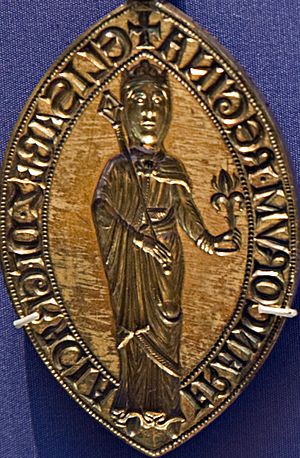Isabella of Hainault facts for kids
Quick facts for kids Isabella of Hainault |
|
|---|---|

Isabella's seal as queen shows her holding a sceptre and fleur-de-lis
|
|
| Queen consort of France | |
| Tenure | 28 April 1180–15 March 1190 |
| Coronation | 28 May 1180 |
| Countess of Artois | |
| Reign | 28 April 1180 – 15 March 1190 |
| Successor | Louis |
| Born | 5 April 1170 Valenciennes, France |
| Died | 15 March 1190 (aged 19) Paris, France |
| Burial | Notre-Dame, Paris |
| Spouse | |
| Issue | Louis VIII of France |
| House | Flanders |
| Father | Baldwin V, Count of Hainaut |
| Mother | Margaret I, Countess of Flanders |
Isabella of Hainaut (born April 5, 1170 – died March 15, 1190) was a Queen of France. She was the first wife of King Philip II. She was also the formal ruler of Artois, a county in France, from 1180 to 1190.
Contents
Isabella's Early Life
Isabella was born in Valenciennes, France, on April 5, 1170. Her father was Baldwin V, Count of Hainaut, and her mother was Margaret I, Countess of Flanders.
When she was only one year old, her father promised her in marriage to Henry. Henry was the nephew of Adèle of Champagne, who was the queen of France at the time.
In 1179, both fathers agreed to the marriage. However, Isabella's father later changed his mind. He then agreed for her to marry King Philip II instead.
Becoming Queen of France
Isabella married King Philip II on April 28, 1180, in a town called Bapaume. As part of her marriage agreement, she brought the county of Artois with her. This was called a dowry, which is like a gift of property or money from the bride's family.
Her uncle, Philip, Count of Flanders, helped arrange this marriage. He was an advisor to the King. The previous queen, Adèle of Champagne, was not happy about this marriage. It meant her nephew would not marry Isabella, and her family's influence would decrease.
Isabella was crowned Queen of France at Saint Denis on May 28, 1180. Some historians believed that Isabella was a descendant of Charlemagne. This marriage was seen as a way to unite two important royal families: the Carolingian and Capetian families.
At first, Isabella struggled to win King Philip's full affection. This was because she had not yet given him a son to be his heir, even though she was only 14 years old.
In 1184, King Philip was fighting a war against Flanders. Isabella's father, Baldwin, supported Philip's enemies. This made King Philip very angry. He decided to call a meeting to try and end his marriage to Isabella.
According to a writer named Gislebert of Mons, Isabella went to the town's churches. She walked barefoot and dressed simply, showing she was sorry. This made the people of the town feel sympathy for her. Their support for Isabella grew so strong that they went to the palace and shouted loudly.
The King's uncle, Robert, stepped in and helped. King Philip decided not to end the marriage. If he had, he would have lost the important county of Artois that Isabella brought with her.
Finally, on September 5, 1187, Isabella gave birth to a son. They named him Louis, and he was the heir the King wanted.
Isabella's Death
Isabella's second pregnancy was very difficult. On March 14, 1190, she gave birth to twin boys. One was named Robert, but he died the same day. The other was named Philip, and he died three days later.
Isabella herself died the next day, March 15, due to problems from childbirth. She was not yet 20 years old. She was buried in the Notre-Dame Cathedral in Paris.
Many people in Paris were very sad about her death because she was a popular queen. Her husband, King Philip, was not with her when she died. He was away fighting in Normandy against Richard I of England.
When King Philip heard the news, he quickly made a truce with Richard. He returned to Paris, visited her tomb, and spent several days mourning. He then went back to Normandy. He even wrote a letter to Pope Clement III, saying how much he missed his wife.
Isabella's son, Louis, became the new Count of Artois after her death. Later, when Louis became king, the county of Artois returned to the French crown.
How Isabella Looked
People at the time described Queen Isabella as having a "noble form and lovely eyes."
In 1858, Isabella's body was examined at the Notre Dame Cathedral in Paris. Measurements showed she was quite tall for her time, about 1.72-1.75 meters (5 feet 8 inches to 5 feet 9 inches).
During this examination, a silver seal was found in her coffin. This seal is now in the British Museum. It is one of the few royal seals from the Middle Ages that still exists today.
Images for kids
See also
 In Spanish: Isabel de Henao para niños
In Spanish: Isabel de Henao para niños


